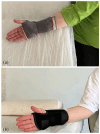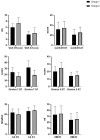Comparison of the Effects of Volar-Assisted and Elastic Wrist Splints on Edema, Pain, Grip Strength, and Functionality in Pregnant Women With Carpal Tunnel Syndrome
- PMID: 38869069
- PMCID: PMC11571782
- DOI: 10.1177/15589447241257647
Comparison of the Effects of Volar-Assisted and Elastic Wrist Splints on Edema, Pain, Grip Strength, and Functionality in Pregnant Women With Carpal Tunnel Syndrome
Abstract
Background: Carpal tunnel syndrome (CTS) is a common musculoskeletal problem in pregnancy. The aim of this study is to compare the effects of rigid and elastic wrist splints on edema, pain levels, grip strength, and upper-extremity functionality in pregnant women with CTS.
Methods: Forty-one pregnant women in the last trimester of pregnancy who were diagnosed with CTS were included in the study. The grip strength was evaluated with the Jamar hand dynamometer, functionality with the Quick Disabilities of the Arm, Shoulder, and Hand and Boston Carpal Tunnel Syndrome Questionnaire, pain with the Visual Analog Scale (VAS), and edema with the water overflow method.
Results: The mean age of the participants was 31.71 ± 5.78 years, body mass index was 28.85 ± 3.63 kg/m2, duration of pain was 2.24 ± 0.79 months, and their pain intensity was 6.63 ± 1.69 according to the VAS. As a result of the study, reductions in pain (P = .001), increases in functionality values (P = .001), increases in grip strength (P = .001), and decreases in edema (P = .001) were observed in both groups after the treatment. However, there was no significant difference in pain, functionality, or grip strength values between the groups after the treatment (P > .05).
Conclusion: In this study comparing the effects of a wrist splint to those of an elastic splint, both treatment methods for pregnant women with CTS decreased pain and edema, increased grip strength, and improved upper-extremity functionality. Considering individual needs, characteristics, and living conditions, both splints can be recommended for pregnant women with CTS.
Keywords: carpal tunnel syndrome; functionality; hand strength; pain; pregnancy; splints; upper extremity; wrist.
Conflict of interest statement
Declaration of Conflicting InterestsThe author(s) declared no potential conflicts of interest with respect to the research, authorship, and/or publication of this article.
Figures



Similar articles
-
Comparison of the efficacy of a neutral wrist splint and a wrist splint incorporating a lumbrical unit for the treatment of patients with carpal tunnel syndrome.Prosthet Orthot Int. 2016 Oct;40(5):617-23. doi: 10.1177/0309364615592695. Epub 2015 Jul 20. Prosthet Orthot Int. 2016. PMID: 26195619 Clinical Trial.
-
An advanced stage of carpal tunnel syndrome - is night-time splinting still effective?Int J Occup Med Environ Health. 2020 Oct 20;33(6):771-780. doi: 10.13075/ijomeh.1896.01611. Epub 2020 Sep 15. Int J Occup Med Environ Health. 2020. PMID: 32929289
-
Comparison of static wrist splint with static wrist and metacarpophalangeal splint in carpal tunnel syndrome.J Back Musculoskelet Rehabil. 2015;28(4):761-7. doi: 10.3233/BMR-140580. J Back Musculoskelet Rehabil. 2015. PMID: 25547237
-
Prevalence of carpal tunnel syndrome in pregnant women.WMJ. 2009 Jul;108(4):194-6. WMJ. 2009. PMID: 19753825 Review.
-
Acupuncture and related interventions for the treatment of symptoms associated with carpal tunnel syndrome.Cochrane Database Syst Rev. 2018 Dec 2;12(12):CD011215. doi: 10.1002/14651858.CD011215.pub2. Cochrane Database Syst Rev. 2018. PMID: 30521680 Free PMC article.
References
-
- Nakamichi KI, Tachibana S. Enlarged median nerve in idiopathic carpal tunnel syndrome. Muscle Nerve. 2000;23(11):1713-1718. - PubMed
-
- Atroshi I, Gummesson C, Johnsson R, et al. Prevalence of carpal tunnel syndrome in a general population. JAMA. 1999;282(2):153-158. - PubMed
-
- Ablove RH, Ablove TS. Prevalence of carpal tunnel syndrome in pregnant women. Wis Med J. 2009;108(4):194-196. - PubMed
LinkOut - more resources
Full Text Sources
Research Materials

